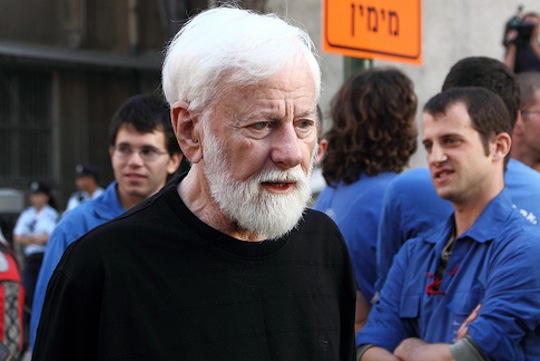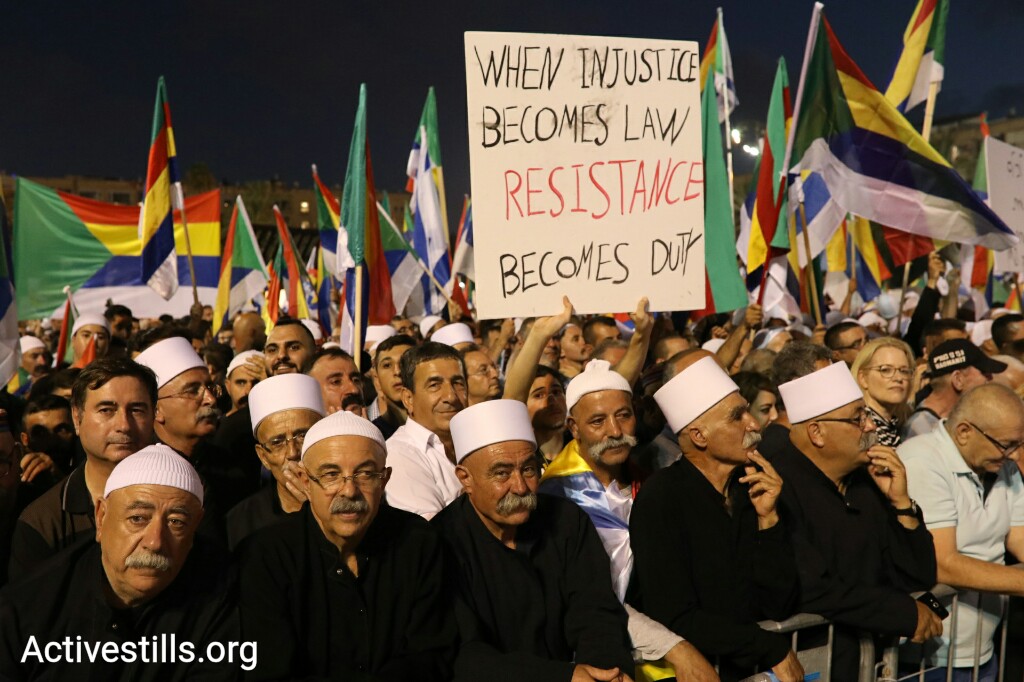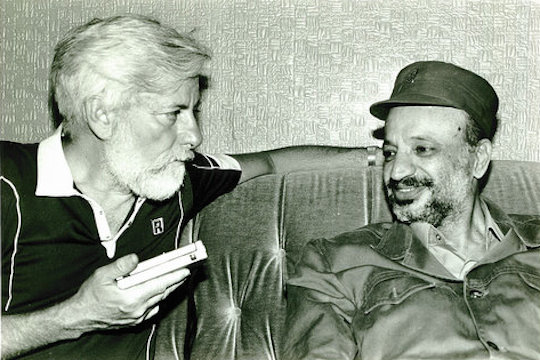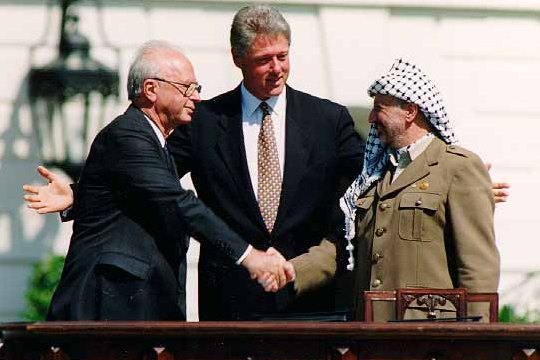Adam Keller, who spent 50 years working alongside Uri Avnery, remembers the man who hoped for a warm embrace between an Israeli and a Palestinian president.
By Adam Keller

How to sum up in a few words 50 years of political partnership, which was also an intimate friendship, with the person who, I believe, had the most influence on me?
The starting point: summer of 1969. A 14-year-old from Tel Aviv, during the summer between elementary school and high school, I notice an ad in HaOlam HaZeh newspaper asking for volunteers at the election headquarters of the “HaOlam Hazeh – Koah Hadash” (“New Power”) party. I went. In a small basement office on Glickson Street, I found three teenagers folding propaganda flyers into envelopes. To this day, the smell of fresh print takes me back to this very moment. Two hours later, we heard a commotion outside. Member of Knesset Uri Avnery, the man whose articles brought us to this office in the first place, walked in. He was returning from an election campaign in Rishon LeZion. He exchanged a few words with the volunteers, thanked us for our help, and went into a meeting room with his aides.
At that point, it was not Uri Avnery’s opinions on the Palestinian issue that motivated me to volunteer for the campaign. My own opinions on the matter were not fully formed yet. Only two years prior, in June of 1967, I had shared with many others in celebrating the fact that Israel expanded into “new territories.” I would not have even imagined that I would eventually dedicate most of my life to trying to get Israel out of those territories. I was attracted to Uri Avnery’s party primarily because it was a young, fresh political party that challenged the old, rotten establishment parties, and because it was opposed to religious coercion, and advocated for separation of religion and state, public transportation on Shabbat, and civil marriage.
A few weeks after I began volunteering, I left a note on Uri’s desk with a few questions: can we really make peace with the Arabs? Should we give back all the territories Israel occupied, or only some? And what will happen with the settlers? (The settler population at the time was a tiny fraction of what it is today.) A week later, I received a letter in the mail – three pages of detailed answers to each one of my 10 questions. I still have that letter. I have no doubt that Uri wrote it himself – his writing style seeps out of every word. He took the time and energy, in the middle of running a political campaign, to provide thorough answers to the questions of a 14-year-old teenager. I think it turned out to be a profitable investment.
The end point: Friday, August 3, 2018. A years-long political partner of Uri Avnery, at 63 years old, I receive his weekly column, as I do every Friday. In this article, he wrote about the Jewish Nation-State Law and Israel’s national identity, and whether it was Jewish or Israeli (he, of course, strongly advocated for an Israeli identity). As I had done many times before, I wrote him an email commenting on the substance of the article, raising some fundamental objections. He suggested we discuss them further next time we meet. I asked for his opinion on the protest against the Nation-State Law, scheduled for the following day by the Druze community. He said he was convinced that the demonstration would not focus on the Druze’s exclusive standing in Israeli society, or the unique bundle of rights they get for serving in the military, but that it will tackle the fundamental principle of equality for all citizens.

The last which I will ever hear from him was a one-line message on my computer screen: “I am going to the Druze protest tomorrow.” I assume that he did read what I had written him, and that he woke up the next day with the intention of participating in the protest. In the evening, when I was standing amidst the large crowd that amassed in Rabin Square, I assumed he was standing somewhere around. I rang his phone twice but there was no reply, chalking it up to bad reception (which is common during mass rallies when very many people use their mobile phones all at once). In retrospect I know that by then he had already been admitted to an emergency room at Ichilov Hospital, never to regain his consciousness. It was the activists who planned to give him a ride to the demonstration who had found him lying on the floor of his apartment.
What filled the 50 years between the start and end points? The HaOlam Hazeh – Koah Hadash party, which merged into Peace and Equality for Israel, a political party known as Shelli in Hebrew; the Council for Israeli-Palestinian Peace, which managed meetings with the Palestinian Liberation Organization and became a faction of Shelli; the Progressive List for Peace, which we joined after Shelli disintegrated; and then Gush Shalom. So many meetings, marches, protests and conversations. So many memories.
Standing side by side, holding posters at a protest to prevent the closure of Raymonda Tawil’s news agency in East Jerusalem. The photo that Avnery’s wife, Rachel, took of that demonstration is still up on the wall of the room I am writing these very words in. A conversation with Avnery the day that HaOlam Hazeh, which he edited for 40 years, officially shut down. “I know this is a difficult day for you,” I said. He answered: “The paper was a tool, serving a purpose. We shall find other tools.”

It is early 1983. Uri Avnery, Matti Peled and Yaakov Arnon, known us the “Three Muskateers,” come back from a meeting with Yasser Arafat in Tunisia. As soon as he lands at the airport, he hands me photos of the meeting, and I bounce from one newsroom to another across Tel Aviv to distribute them in person. I then take a shared taxi to Jerusalem where Ziad Abu Zayyad, editor of the Palestinian Al-Fajr (“The Dawn”) newspaper, waited for me.
A bit later in 1983, the radio announcing the assassination of Issam Sartawi, a PLO member who often met with Avnery and was a close friend to him, and my phone call to Uri informing him of the sad news. The frustrating, endless phone calls in the couple of days that followed proved to us that it was impossible to rent a hall in Tel Aviv to commemorate a PLO man – even one who advocated for peace with Israel and was killed for it.
December 1992. Prime Minister Rabin, who had not yet signed the Oslo Accords and had not yet become a hero of peace, expels more than four hundred Palestinian activists to Lebanon, and we put up a protest tent in front of the Prime Minister’s Office. It is a cold Jerusalem winter, and it is snowing, but inside the tent that was donated by Bedouins from the Negev, it feels warm and cozy. Uri, Rachel, myself and my wife Beate join other activists in a long conversation with Sheikh Raed Salah, head of the northern branch of the Northern Branch of the Islamic Movement in Israel, on Judaism and Islam, and how religion and politics converge and clash.
In 1997, in the middle of a protest in front of Har Homa – Netanyahu’s flagship settlement – Uri’s stomach wound, which he had been carrying since the war in 1948, breaks open. A Palestinian ambulance clears him to Al-Makassed Hospital in East Jerusalem; we are all anxious. Rachel tells me, “even though I do not believe in God, I am praying.” But Uri recovers and lives on for 21 more years of intensive political activity.
May 2003, the Muqata’a (presidential compound) in Ramallah. That afternoon, there was a suicide bombing in Rishon LeZion, and Prime Minister Ariel Sharon drops a hint that he might send an elite IDF unit to “handle” Yasser Arafat that night. We are among 15 Israeli activists who go to Ramallah to serve as human shields. We call the media and tell them that “for the Prime Minister’s information, there are Israeli citizens sitting outside of Arafat’s door!”

Arafat shows Uri his gun and says, “if they come, I have a bullet in here for myself.” We spend an entire night at Arafat’s door, having conversations with young Palestinian guards in a mix of Arabic, Hebrew, and English, paying attention to every sound. Then, it is dawn, and we understand that we made it through the night safely, and that the soldiers will not be coming.
Another long, relaxed conversation when we stopped to eat something on our way back from a Progressive List meeting in Nazareth: “The Crusaders were here before us, they came from Europe and established here a country that lasted 200 years. Not all of them were religious fanatics. Among them were people who spoke Arabic and had Muslim friends. But they were never able to achieve peace with their neighbors or adapt to this region. They had temporary agreements and ceasefires, but were not able to gain real peace. Acre was their ‘Tel Aviv,’ and when it fell, the last Crusaders were thrown into the sea – literally. Those who do not learn from history are bound to repeat it.”
“If I ever get the chance to serve as a minister, I would want to be education minister. That is the most important portfolio in the cabinet. The defense minister may be able to send soldiers to die in war, but the education minister can shape children’s consciousness. The policies of today’s education minister will still bear manifest results in 50 years, when today’s children become grandparents and talk to their own grandchildren. If I were the minister, the first thing I would do is remove the [biblical] Book of Joshua from the curriculum. That book advocates genocide, plain and simple. It is also a historical fiction – the events it describes never happened. Rachel was a teacher for 40 years, and every year she succeeded in avoiding teaching this trash.”
Rachel accompanied him everywhere, an active partner to everything he did, editing his articles and dealing with the all the logistics of organizing protests. We all knew she was a hepatitis B carrier, a time bomb that might explode at any minute. And when it finally did, Uri spent six months with her in the hospital, day and night. He almost had disappeared from political life. One day, I happened to bump into him in the hallway of Ichilov Hospital as he was pushing her in a wheelchair, from one checkup to another.
In her final weeks, someone told Uri of an experimental treatment that could save Rachel’s life. Although he knew the chances were slim, Uri spent large sums of money to purchase the medication in America and have it flown to Ben Gurion Airport, and from there, transported directly to the hospital. When she passed away, Uri asked that nobody contact him for three days, and he completely disengaged from the world. Once those three days were over, he went back to his routine of protests and political commentary – or so it seemed.
How to finish off this article? I will go back to 1969, to an article by Uri which I read under the table during a very boring class in eighth grade. I still remember it, almost word for word; it was a futuristic article that attempted to imagine what the country would look like in 1990. The page was split into two parallel columns, representing two parallel futures. In one of the futures, Independence Day in 1990 is marked by a tremendous manifestation of military power, with new tanks on display in Jerusalem. Prime Minister Moshe Dayan congratulates IDF soldiers who are on alert in the Lebanon Valley and the Land of Goshen near the Nile, and declares: “We shall never give up the city of Be’erot (formerly Beirut), this is our ancestral homeland!”
In the second future, on Independence Day in 1990, festive receptions are being held at Israeli embassies across the Arab world, but the most moving photo was captured in Jerusalem, of a warm embrace between Israeli President Moshe Dayan and Palestinian President Yasser Arafat.
Adam Keller is an Israeli peace activist who was among the founders of Gush Shalom. This article was first published in Hebrew on Local Call. Read it here.
